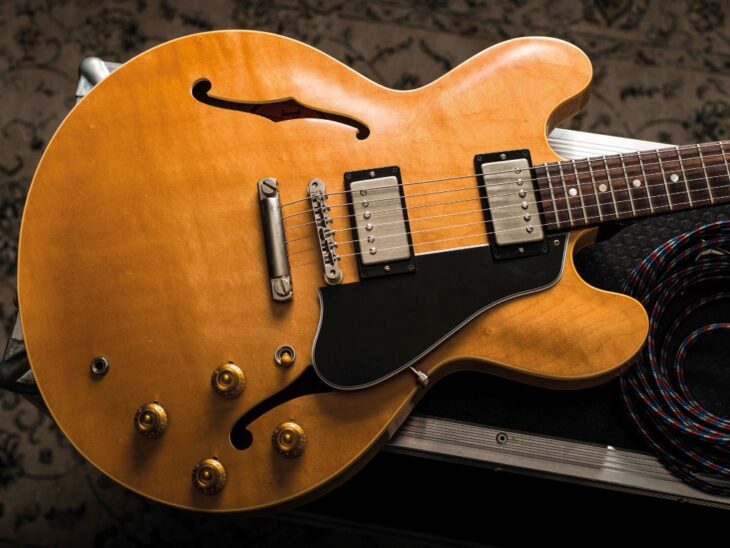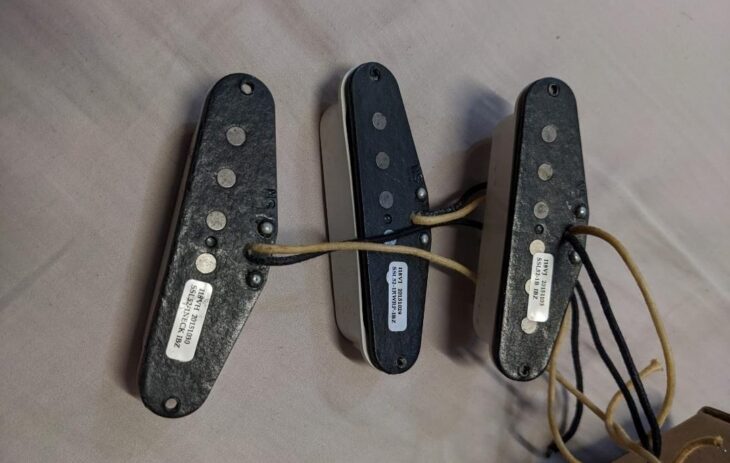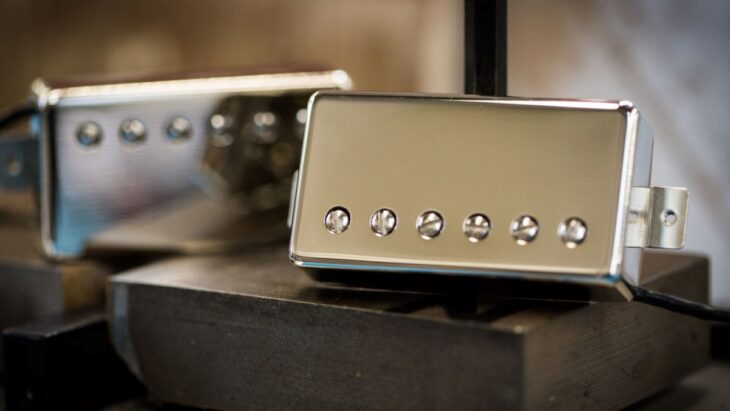All guitars are made from the same two things… metal and wood. So why then do they all sound so uniquely different?
The answer is pickups.
Responsible for as much as 80% of your true tone, you’ve got the choice of either alnico alloy or ceramic style pickups, each with its own strengths and weaknesses.
Today, we’re gonna take a look at two of the most popular Alnico style pickups out there, the Alnico 2 and 5, to hopefully help you make the right decision about your next guitar.
Table of Contents
What is a Guitar Pickup, and How Do They Work?

I’m gonna let you in on a little secret… they’re just magnets.
Electromagnets to be specific. At its most basic, a guitar pickup is just one or more magnets inserted into a steel cylinder or bobbin, with conductive wire wrapped around it.
Your pickups work by giving off a constant electromagnetic signal that can be manipulated by the vibrations of your strings. The vibrations are “picked up” and transformed into electrical energy by the pickups and sent to your amp.
Okay, science lesson over, let’s take a look at some of the most popular types of magnets used in guitar pickups today — the Alnico 2 and 5.
Alnico gets its name from the three metals used to create the magnets alloy — (Al)uminium, (Ni)ckle and (Co)balt.
Alnico Pickups – Overview
Alnico 2

The Alnico 2 is the second weakest magnet in the Alnico line and is known for its warm, smooth tones. It’s got a real “vintage” sound and was the magnet of choice in the old Humbuckers of the ‘50s and ‘60s.
If you aren’t bothered about playing loud, an Alnico 2 magnet is the way to go. They’ve got a relatively low output and a much larger focus on the mid-range, instead of booming bass and shrieking high-ends.
They aren’t as common anymore, but you can still find Alnico 2 pickups on vintage re-releases like Gibson’s updated Les Paul Standard 60s.
Currently, popular options include the Gibson Classic ‘57 Humbucker and the EVH Frankenstein Plus.
Alnico 5

The Alnico 5, meanwhile, is everything the 2 is not.
Loud, clear and bright, the 5 is the second strongest alnico magnet on the market and has become a popular choice in modern rigs because of its clarity and definition of sound.
If you like to use pedals and effects when you play, you’d benefit from the Alnico 5’s higher-output and “hotter” tones as they stay clear no matter how much fuzz you stick on it.
All musicians love the 5’s; their clarity and articulation have helped to define so many different styles and can be found everywhere, from the jazz/rock-focused Gibson ES-335 to the heavy metal machine that is the Jackson American SL3.
Popular Alnico 5 pickups include Seymour Duncan’s SH-4 JB bridge humbucker, SSL-5 high-output single coil, and Fender’s Custom Shop Texas Strat Pickups.
Alnico 2 vs 5 – Head to Head
Tone

The most obvious tonal difference between these two magnets is in the clarity of sound. The 2 has a more vintage “squawk” to it, while the 5 is naturally a lot cleaner and more well-defined.
Choosing between the 2 or 5 should come down to the type of music you play. The Alnico 2 is the perfect blues and classic rock companion — warm, mellow, and fuzzy right out of the box.
The 5, meanwhile, is so clean it’s almost sanitized. They have an open top end that sparkles and a stronger low end, which makes them a popular choice for metal and heavy rock.
As a blues musician, I find the 2’s vintage sound more pleasing and emotive, with the 5’s almost feeling sterile and way too clean for my taste.
If you want the best of both worlds, you can pick yourself up these Seymour Duncan SSL-52 Single Coil Strat pickups that use both 2’s and 5’s to give you that vintage warm tone, without sacrificing clarity and definition.
Output
Output is an important thing to consider when choosing between these two magnets.
The Alnico 2 pickups have a much lower output when compared to its bigger, meaner brother. So, if you’re trying to emulate players like Jimmy Page or Eric Clapton, you’ll want to stick to the lower-output crunch of the 2.
Hard rock, garage rock, and metal players should really avoid the 2’s because they just aren’t hot enough to keep up with the high-output sound those genres require. They’re just not loud enough.
The Alnico 5’s higher-output means they’re way easier to clean up and distort. So, if you like to use pedals and effects, you’re gonna have a much easier time getting a good sound out of Alnico 5 magnets.
Playability and Versatility
This one is a little less clear-cut.
Because of the 5’s higher output, guitars that use this type of pickup are louder and therefore more sensitive to the touch. The increased clarity also means every wrong note or muted string cuts through the mix and stands out.
The 2’s vintage “fuzz”, in my opinion, is a lot more beginner friendly as it’ll mask some of the imperfections in your playing and be a lot less reactive to you hitting its notes.
But that comes at the cost of the 2’s being way less versatile. The extra clarity the 5’s offer means effects don’t muddy the mix as much and you’re able to do a lot more with your guitar.
Comparison with Alnico 3 and 4

But if you’re put off by the vintage tones of the 2, and think the 5 sounds too harsh, there is a middle ground.
The alnico 3 is the weakest of the alnico magnets. It’s got a naturally dark tone and sounds glassy, like a permanent strat neck pickup.
It’s the quietest through a clean amp and doesn’t distort very well. They’re not super common, but you can still find these magnets on Fender re-releases, like the Fender Vintera ‘50s. A noteworthy Alnico 3 pickup that’s still available is the Gibson Custombucker.
The alnico 4 on the other hand aims for one thing. Balance. It has more output than Alnico 2 and 3 but is weaker than Alnico 5. People often describe the 4 as having the most balanced EQ.
It’s worth keeping in mind, the 4 is the last Alnico magnet that’ll give you that subtle “squawk” some people look for in their pickups. Once you’ve crossed over to the Alnico 5, the natural tone gets cleaned up considerably.
Popular Alnico IV options include the Seymour Duncan Saturday Night Special Humbuckers, Fender Yosemite, and Fender Double Tap Humbucker.
Final Thoughts
Both the Alnico 2 and 5 are great pickups but you need to keep in mind their limitations. They’re designed to do different things, and no amount of cleaning the mix will make an Alnico 2 sound like a 5.
At the same time, certain vintage tones cannot be replicated with pedals and effects, so no matter how clear the Alnico 5 is, using it to get tones like the guitar gods of yesteryear is futile and will leave you frustrated and confused.
You need to ask yourself what it is you want to play. Once you’ve got that down, the answer as to which type of pickup magnet to get becomes a lot simpler.


The Seymour Duncan El Diablo pickup has a higher output than any Alnico V pickup, but it uses Alnico II magnets. So, what does that tell us?
Great summary, very useful in this day and age..
Worth pointing out a few clarifications.
Until you pluck a string, there is only a magnetic field, not electromagnetic. The magnet serves only to magnetize the string, and when the magnetized string is plucked it creates an electromagnetic field which is picked up by the coil like a microphone. If you place the magnet above the string instead of near the coil, it works the same way.
Gibson used alnico 2,3,4 and 5 interchangeably during the Burst period.
The Standard 60s model uses Alnico 5 magnets.